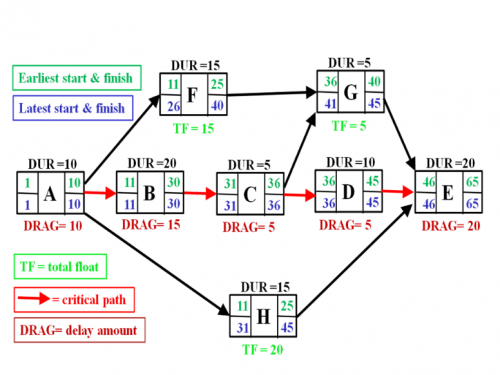Understanding the Critical Path Method
Published on August 7, 2020 by Zach Francis

What is the Critical Path Method?
Whether you have heard of the critical path method (CPM) or not, it is a valuable project planning method that can save you time and help you complete more projects during the busy season.
According to Techopedia, CPM is a step-by-step methodology or technique for planning projects with numerous activities that involve complex, interdependent interactions (such as building a home). One of the main benefits to using this method is being able to complete projects in the shortest time possible by identifying critical/non-critical tasks to prevent conflicts and bottlenecks.
Take a look at the diagram above to get a better idea of the process. Let us know if you plan on using CPM for any projects in the future!

What do the letters mean?
The letters a b c d e f g and h are all tasks that need to be completed to finish the project.
What does DUR= mean?
The DUR= means the duration of the task or how many days this task will take to complete. So, DUR=10 means that this is a 10-day task.What does DRAG= mean?
DRAG= the amount of time that the task is adding to the total project. So, DRAG=10 means this task is adding 10-days to the project.
What does TF= mean?
This is the total float. Total float is the leeway that you have to schedule and complete this task. If the DUR=15 and the TF=5 that you have 5 days of leeway to start the task or the task will extend out the completion date of the project.
What do the dark green numbers mean in this diagram?
These are the earliest start and finish days for the task. So, lets look at task F. Task F at its earliest can start on the 11th day of the project and is that task is started on the 11th day than it will be completed on the 25th day.
What do the blue numbers mean in this diagram?
The blue numbers are the latest start and finish days. The latest that task F can be started is the 26th day of the project. If the task is started on the 26th day of the project than it will not be completed until the 40thday of the project.
What do the red arrows mean?
The red arrows specify tasks that must be completed in succession. This means that task a must be complete before task be can be started. In this diagram let's say that task a is staking the property and task B is excavation. You can not start the excavation until the lot is properly staked.
What do the black arrows mean?
The black arrows are tasks that can be completed as other tasks are being performed. In this example lets look at task F. Task F is waterproofing the foundation walls. Task F can be completed while the other work is being performed such as framing. So task F is not adding extra days to the project.
